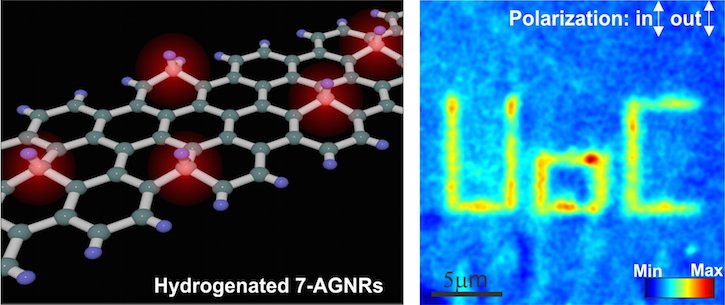Scientists make Graphene nano ribbons shine
|The element silicon is the basis of almost all electronic applications in use today. You will find it from processors in personal computers to photovoltaic cells for the generation of green energy. On the other hand, five decades of intensive research and development have pushed silicon-based electronics to its limits and more and more research is dedicated to develop new materials for the inevitable post-silicon electronics era. One-dimensional graphene nanoribbons (GNRs) are ideal candidates for materials to eventually replace silicon in electronic applications. GNRs are, as their name suggests, small strips of graphene single layers, usually with a width less than 50 nm. These nanoribbons show the same behaviour of classical silicon semi-conductors, but on a much smaller scale, which would allow, for example, to produce smaller and faster processors. Despite the interesting electronic properties of GNRs, their photoluminescence, the ability to emit light, is rather low. Photoluminescence is important for future electroluminescent devices (e.g., LED) on the basis of GNRs instead of silicon.

The research teams around Prof. Alexander Grüneis and Prof. Klas Lindfors from the University of Cologne in Germany have taken up the challenge of creating GNRs with higher photoluminescence. In a recent study, they developed a method to produce layers of specially designed GNRs onto insulating carriers like gold. They used a set of instruments including CERIC’s BaDElPh beamline at the Italian CERIC facility, Elettra Sincrotrone Trieste, to make a full photo-physical characterisation of these GNRs. On the basis of the obtained data, they found out that they could enhance the photoluminescence of their GNRs by exposing them to strong blue laser irradiation. This method worked so well, that it was possible to perform laser writing on the GNR layers. These important developments set the stage for further explorations of the optical properties of GNRs and opens doors to new electronic devices’ design.



